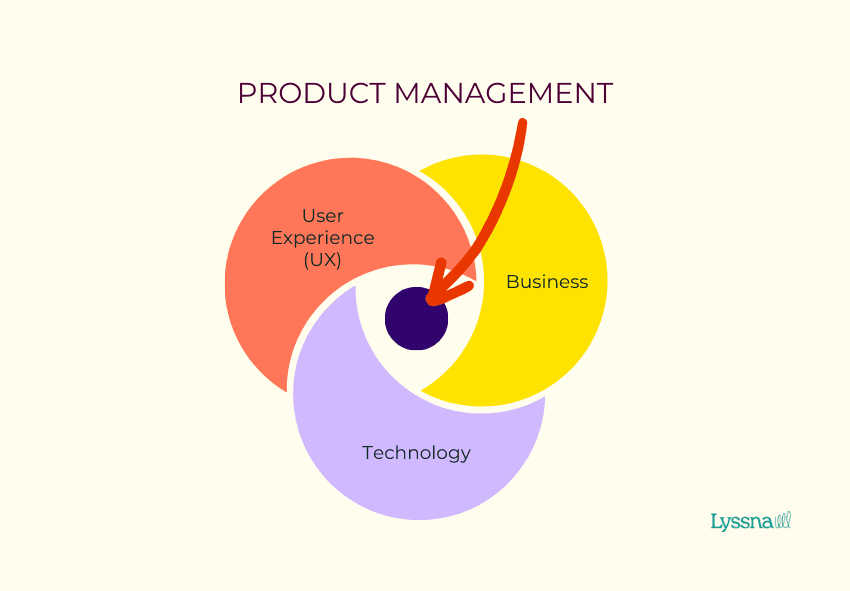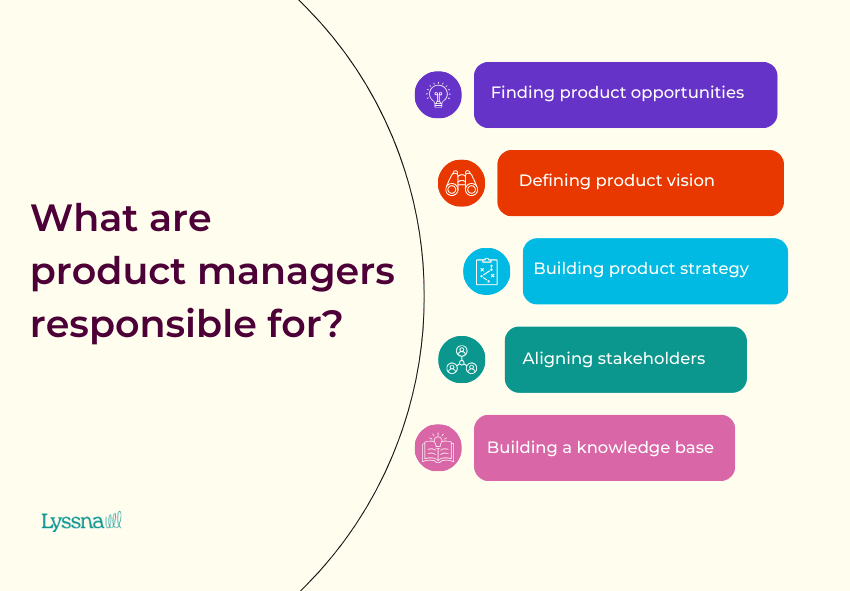14 Nov 2025
|13 min
What does a product manager do
Discover the tasks, responsibilities, and skills of product managers. Learn from a senior product manager's experience and find out how to kickstart your PM career.

Some of the most famous founders and CEOs of the modern world (think Jeff Bezos, Steve Jobs, Bill Gates, and Larry Page) all identified product opportunities, built a product strategy, defined their products, inspired others, and advocated for their products.
If they didn’t give themselves the top titles they would, by any other definition, be product managers.
We’re not saying that by being a product manager you’ll magically become rich, famous, and a historical figure (although you never know). We are saying, however, that product management is an exciting, varied, and often challenging role. Since you’re reading this, chances are you’re curious about what this career path looks like and how you can get started.
In this article, we interview our Senior Product Manager here at Lyssna, Maureen Chiu, who shares her words of experience and encouragement. By the end of the article you’ll understand:
What a product manager is
The differences between a product manager and a product owner
The responsibilities and tasks that come with being a product manager
The skills you need to succeed as a product manager
How to get started with a career in product management
Ready to transform your career? Let’s jump in.
What is a product manager?
In the 1980s, an academic article by Carl McDaniel and David A. Gray described the product management role as follows:
“The objective of product management is to focus managerial attention on specific products or brands which could not be adequately managed by one person. In its original form, the product manager’s position included:
Creation and conceptualization of strategies for improving and marketing the assigned product;
Projection and determination of financial operating plans for such products; and
Monitoring execution and results of plans with possible adaptation tactics of evolving condition.”
While this definition makes sense, it’s pretty old and stuffy. These days, the product manager role sits within the intersection of user experience, technology, and business.

That’s to say, product managers are the people who make decisions and trade-offs in these areas. They identify customer needs (user experience), the business objectives a product addressing those needs could fulfill (business), and create product management roadmap for execution (technology).
We’ll get into role responsibilities in more detail below, but first, it’s worth exploring the distinction between a product manager vs product owner, as the two roles often overlap but serve different functions.
What is a product manager vs a product owner?
Product managers and product owners are separate roles with different responsibilities. Some businesses might employ someone to take on both roles, but this isn’t necessarily sustainable in the long term.
That being said, the simplest way to explain the difference between the two roles is this: product managers are the strategic arm of the business while product owners are the tactical arm.
A product manager will determine the long-term vision of the product. Their focus is usually outward – looking at market trends; working with sales, marketing, and customer support teams on product launches; and often doing budgeting and forecasting.
A product owner takes the long-term vision of the product manager and turns it into actionable tasks for delivery. Their focus is typically inward – coordinating and attending meetings and organizing product testing and demos.
The product owner role came from the Scrum framework for agile project management and, as a result, you tend to find these positions in businesses that use an agile product-driven development approach.
It’s also worth noting that some businesses hire multiple product managers, with some being more strategy-focused (traditional) and some more delivery-focused (tactical). The latter can be very similar to a product owner role.
What are product managers responsible for?

Now we’re getting to the specifics. If you become a product manager, what responsibilities will you have?
At a high-level, product managers are responsible for:
Finding product opportunities.
Defining product vision.
Building the product strategy.
Aligning stakeholders so everyone is on the same page.
In many cases, building a knowledge base so individuals can make decisions independently.
There are also specific responsibilities that Maureen highlights:
“When I'm talking about strategy, I'm talking about things like market analysis, product positioning, and messaging. You might be looking at things like pricing and packaging, as well. But on the delivery side of things, you might have these great big features on your product roadmap, but then how do you actually break this down? You’ll need to prioritize what your MVP is and work with engineering teams to break this into buildable pieces.”
As you can see, the responsibilities of product managers are quite varied, which is why the role commands an average salary of $146,875 in the US (at the time of publishing).
What are the tasks of a product manager?
Let’s get down to the gritty stuff – what project managers actually do on a day-to-day basis. The specific tasks will vary depending on the stage of the product lifecycle you’re in.
Pre-development phase
If a product or feature is in the pre-development stage, product managers work on customer research and market analysis to figure out what customers need and if those needs present a good use case for the business. This can include tasks like:
Customer interviews.
Organizing focus groups.
Competitor analyses.
Curating and managing a backlog of ideas based on company goals and user needs.
Once a product manager finds a good idea, they build the business case for it by writing a product specification document, which includes the overall vision and direction, product requirements, outlining and defining its ‘why’, what it will achieve, and how success will be measured.
Development phase
If a product idea has been approved and is ready for development, a product manager’s first task is usually to build out a product roadmap to help prioritize tasks into what needs to be built and when.
From there, the role can vary depending on the size of the company and the project, as well as seniority. But in general, product managers are expected to complete the following tasks:
Write user stories with the help of engineering, development, and design teams, turning points of those stories into tasks.
Work closely with customers, stakeholders, and development teams to build product prototypes using some of the best UI prototyping tools, conduct usability testing, and refine the product based on feedback.
Communicate and present to leadership teams to get approval and budget (if applicable) for product initiatives (especially for any changes to the initial product spec).
Communicating regularly with teams to ensure the product roadmap stays on schedule.
Post-development phase
After initial development, product managers work closely with marketing, sales, and customer support teams to make sure the product launches smoothly. Tasks here can include offering timely updates to key team members, demoing the new product or feature, and assisting marketing to ensure copy and launch materials are accurate.
After launch, product managers will often continue to work with teams to drive the adoption of the new product/feature. They may also work with UX researchers to find any opportunities for improvement or changes.
This leads us right back to the beginning of the cycle.
Your go-to user research platform
The best teams use Lyssna so they can deeply understand their audience and move in the right direction — faster.
What skills do you need to become a product manager?

As you can probably tell, product managers need to have a variety of skills – with excellent communication and organization being a minimum requirement. However, there are several other skills you’ll need to have or develop as you grow in a product management role, including:
Being able to conduct data analysis and pull key insights.
Understanding the principles of team management/leadership, UX design, market research, software development (if applicable), product development, and business and finance.
Being able to empathize with customers and stakeholders.
Top-notch problem-solving skills, because there are always technical, organizational, and operational constraints to work with.
When we asked Maureen about the skills you need for product management, she said:
“Practically speaking, I think it's about having that right balance between strategy and delivery. Or at least having the right balance in relation to the company you work for, because some might be looking for a product manager who has much more of a strategic focus versus a delivery focus, and vice versa.
It's about building skills over time and getting exposure to different things. Not necessarily just projects, but also different companies, teams, and ways of working. So that, when you're a more seasoned PM, you can really draw upon your experience in both the strategy and delivery sides of things.”
Building on this point of growing experience and developing your skills, she adds:
“I think in terms of what skills you need, it's really experience on both sides of strategy and delivery. When you're working as a product manager you can be, on one hand, working with the leadership team on the strategy of your product, and on the other working with the technology team and your go-to market team. So that could be your marketing teams, or support teams, to bring that product to your customers.”
So as Maureen points out, experience helps you become successful in pursuing future product management roles. But that begs the question, how do you get that experience in the first place?
How do you get into product management?
Product management, at least in the form it’s in today, is a relatively new field. And given Maureen’s advice about the importance of experience, it can feel like a chicken and egg scenario – you need experience to get experience.
We asked Maureen if she’d suggest trying to get a junior product management role in order to gain that initial experience.
“I think you should really lean in on what your strong suits are. So when you start off in your career, if you haven't had any formal PM training, but assuming you have some other work experience, whether it be technical, UX, or business – like maybe you come from a commerce background – lean in on your strong suit when applying for your first product role.
It doesn't necessarily need to be a junior PM role; it could be a product owner, because then you'll be closer to the delivery side. Or you could be a UX designer or an engineer looking to change careers. I think what's important is talking to your employer and telling them you're interested in product management.
And it's a two-way street. It’s mutually beneficial to say, “I want to stay here, I want longevity in this company, and I want to work as a product manager here.” And so for them, they really should be investing in your career as well, and giving you those opportunities.”
Another point Maureen brings up is to look for a company that’s constantly building, even if it’s small releases. This way, you get more chances to be part of an end-to-end experience.
If you’re worried about not having a formal education in product management, Maureen didn’t either! While formal education is useful for building fundamentals, you’ll learn a lot of specific skills on the job.
On this point, Maureen says:
“When people are looking for junior PMs or for business analysts or product owners, you're not necessarily – in my hiring experience, anyway – I'm not necessarily looking for someone with a bachelor's degree. I'm looking for people who have shown an interest and are being proactive about how to enter this industry.”
While there are product management courses available, Maureen emphasizes that they’re typically designed for existing product managers looking to upskill or for more senior positions (because they’re often expensive).
So while getting experience in product management might sound elusive at first, it’s about being able to apply your existing knowledge and skills and negotiating with your employer (if you can) to work on projects that will help you move into a formal product management role.
Looking to gain some research experience?
In this article, we’ve shown that getting into product management means knowing how to understand and empathize with your customers.
With Lyssna, you can conduct user tests to help you understand your product and its potential users better, getting you that important practical experience and know-how for the job.
Elevate your research practice
Join over 320,000+ marketers, designers, researchers, and product leaders who use Lyssna to make data-driven decisions.
FAQ

Alexander Boswell
Technical writer
Alexander Boswell is a product-led content writer and researcher with a background in marketing strategy and consumer behaviour. When he’s not writing, he’s playing baseball and D&D.
You may also like these articles


Try for free today
Join over 320,000+ marketers, designers, researchers, and product leaders who use Lyssna to make data-driven decisions.
No credit card required





